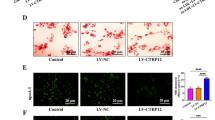Abstract
Objective
To propose and verify a hypothesis that miR-17-5p knockdown may mitigate atherosclerotic lesions using atherosclerotic ApoE−/− mice as serum microRNA-17-5p (miR-17-5p) is elevated in patients with atherosclerosis.
Results
The level of miR-17-5p was higher while the level of very low density lipoprotein receptor (VLDLR), a predicted target of miR-17-5p, was lower in the peripheral blood lymphocytes (PBLs) of atherosclerosis patients as compared with control PBLs. ApoE−/− mice fed with a high-cholesterol diet displayed marked atherosclerotic vascular lesions, which were ameliorated after treatment with antagomiR-17-5p. Moreover, the decreased VLDLR in atherosclerotic mice was partly restored when miR-17-5p was antagonized. Further, luciferase assay confirmed VLDLR as a direct target of miR-17-5p in vascular smooth muscle cells (VSMCs). In addition, the elevated expression of proprotein convertase subtilisin kexin 9 (PCSK9), a secreted protease that binds to and promotes VLDLR degradation, in the atherosclerotic mice was suppressed by antagomiR-17-5p.
Conclusions
A novel interaction between miR-17-5p and VLDLR is revealed and suggests that miR-17-5p may be a potential therapeutic target for AS.




Similar content being viewed by others
References
Alvarez ML, Khosroheidari M, Eddy E, Done SC (2015) MicroRNA-27a decreases the level and efficiency of the LDL receptor and contributes to the dysregulation of cholesterol homeostasis. Atherosclerosis 242:595–604
Bentwich I et al (2005) Identification of hundreds of conserved and nonconserved human microRNAs. Nat Genet 37:766–770
Casscells W (1992) Migration of smooth muscle and endothelial cells. Crit Events Restenosis Circ 86:723–729
Chen YC et al (2013) A novel mouse model of atherosclerotic plaque instability for drug testing and mechanistic/therapeutic discoveries using gene and microRNA expression profiling. Circ Res 113:252–265
Chen J, Xu L, Hu Q, Yang S, Zhang B, Jiang H (2015) MiR-17-5p as circulating biomarkers for the severity of coronary atherosclerosis in coronary artery disease. Int J Cardiol 197:123–124
Cheng Y et al (2009) MicroRNA-145, a novel smooth muscle cell phenotypic marker and modulator, controls vascular neointimal lesion formation. Circ Res 105:158–166
Doebele C et al (2010) Members of the microRNA-17-92 cluster exhibit a cell-intrinsic antiangiogenic function in endothelial cells. Blood 115:4944–4950
Eck MV et al (2005) Role of the macrophage very-low-density lipoprotein receptor in atherosclerotic lesion development. Atherosclerosis 183:230–237
Filipowicz W, Bhattacharyya SN, Sonenberg N (2008) Mechanisms of post-transcriptional regulation by microRNAs: are the answers in sight? Nat Rev Genet 9:102–114
Lusis AJ (2000) Atheroscler Nat 407:233–241
Perez-Sanchez C et al (2016) Atherothrombosis-associated microRNAs in Antiphospholipid syndrome and Systemic Lupus Erythematosus patients. Sci Rep 6:31375
Poirier S et al (2008) The proprotein convertase PCSK9 induces the degradation of low density lipoprotein receptor (LDLR) and its closest family members VLDLR and ApoER2. J Biol Chem 283:2363–2372
Tacken PJ, Delsing DJ, Gijbels MJ, Quax PH, Havekes LM, Hofker MH, Van Dijk KW (2002) VLDL receptor deficiency enhances intimal thickening after vascular injury but does not affect atherosclerotic lesion area. Atherosclerosis 162:103–110
Tiebel O et al (1999) Mouse very low-density lipoprotein receptor (VLDLR): gene structure, tissue-specific expression and dietary and developmental regulation. Atherosclerosis 145:239–251
Zhang Y, Ma KL, Ruan XZ, Liu BC (2016) Dysregulation of the low-density lipoprotein receptor pathway is involved in lipid disorder-mediated organ injury. Int J Biol Sci 12:569–579
Supporting information
Supplementary Table 1—Primer information used for RT-PCR analysis.
Supplementary Figure 1—The expression level of VLDLR after treatment with or without antagomiR-17-5p in the heart of atherosclerotic ApoE−/− mice by Western blot analysis.
Author information
Authors and Affiliations
Corresponding author
Ethics declarations
Conflict of interest
The authors declare no conflict of interest.
Electronic supplementary material
Below is the link to the electronic supplementary material.
Rights and permissions
About this article
Cite this article
Tan, L., Meng, L., Shi, X. et al. Knockdown of microRNA-17-5p ameliorates atherosclerotic lesions in ApoE−/− mice and restores the expression of very low density lipoprotein receptor. Biotechnol Lett 39, 967–976 (2017). https://doi.org/10.1007/s10529-017-2337-y
Received:
Accepted:
Published:
Issue Date:
DOI: https://doi.org/10.1007/s10529-017-2337-y




